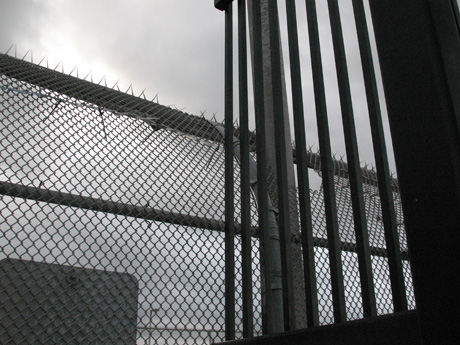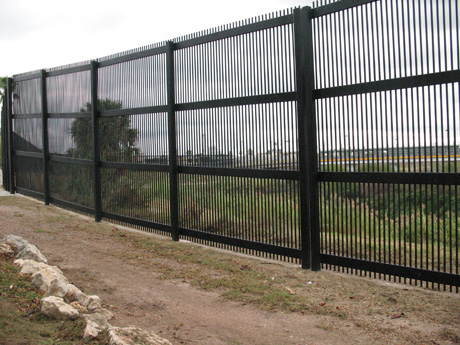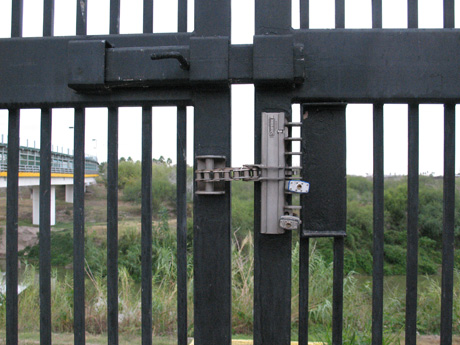by Mark Karlin, Truthout / News Analysis
Sunday 11 March 2012
This is the first in an occasional Truthout series on viewing the
US "immigration" and Mexican border policies through a social justice
lens, focusing on the lower Rio Grande Valley. Brownsville, Texas, area.
Mark Karlin, editor of BuzzFlash at Truthout, visited the region
recently to file these reports. (Photos by Mark Karlin)


The physical Mexican-American wall starts as a newly fortified metal barrier extending 300 feet into the warm, balmy waters of Southern California
and ends up some 2,000 miles later just east of Brownsville, Texas. But
it would be wrong to think of it as continuous, because only about a
third of that distance has some form of visible barrier running like a
scar across the US border with Mexico.

The origins of the billions of dollars spent on the largely symbolic,
highly visible wall really starts much farther north with US
organizations and people advocating for a white political power
structure, groups like one recently represented at the Conservative
Political Action Conference (CPAC), which contend that a multicultural society is a danger to America. The wall also begins with the efforts of states like Arizona to erase Mexican-American culture from the textbooks
in state schools, even in districts where the vast majority of students
are of Mexican descent. It begins with Republicans such as Mitt Romney
welcoming the endorsements of white nationalists who campaign at his side.
It starts with draconian Alabama's, Arizona's and Georgia's harsh
anti-"immigrant" laws that are spreading to many state legislatures,
born of racism and self-serving industry lobbies such as privatized prisons.
The construction of the "barrier" wall - accompanying large-scale
militarization (the Border Patrol, Immigration and Customs Enforcement,
the FBI, the Drug Enforcement Agency, the FBI, the military etc.) - is
on America's southern border, and there is meaning in that. Its location
is prima facie evidence that the "immigration issue" is really a
euphemism for keeping poor brown-skinned people out of the US - as well
as creating a "practice" zone for protecting American economic and
political interests in Mexico and Central America.
Migration Is Not About Opportunism; It's About Survival
The overwhelming majority of migrants from Mexico who seek undocumented
entrance to US are desperate, not gold diggers. They are often victims
of an indigenous subsistence agricultural and rural economy that is disappearing,
due to NAFTA and US subsidies of American farmers, who can sell for
lower competitive prices "south of the border." Often facing an arduous,
dangerous trip up from southern Mexico or Central America, they are
willing to confront possible death in the deserts, sometimes relying on
treacherous "coyotes" (guides), who claim to offer them safe passage to
the US in return for exorbitant fees, and professional criminals, who
abuse and steal from them as they head to the border.
The strong anti-"immigration" laws of many states and the harsh
enforcement of the federal government, however, may be backfiring,
because migrants in dire economic need will work for very little under
squalid conditions - and, therefore, are a valued "commodity." A 2011
Christian Science Monitor article notes that in Alabama, "farmers fearing a labor shortage are protesting recent immigration laws
they say are too harsh, forcing undocumented workers to flee to prevent
deportation." The farmers say, "US workers are unwilling to endure the
rigorous conditions of farm work and that" local farmers may go
bankrupt. But the proponents of white American exceptionalism have no
tolerance for a multicultural society, even if such a stance hurts the
US agricultural (and other low-pay labor areas) financial penchant for
labor exploitation.

Can the US Wall Off a Culturally Diverse Society?
"It seems to me that the notion of a literal wall between Mexico and
the US signifies both the physical and existential threat that many
white Americans perceive from those with darker skin," Timothy Wise, an
expert on how the fear of power being shared in America by its diverse
population is creating racial anxiety in many whites, told Truthout. "On
the one hand, there is the sense that such persons are literally going
to harm us - through crime, the mythical overuse of taxpayer funded
services or some other thing - and on the other, the larger paranoia
that they pose a threat to the cultural and social survival of America
as 'we have known it'."
Recently, I stood in downtown Brownsville on a sliver of land
ironically called "Hope Park." I read about how ferries used to cross
the narrow stretch of the Rio Grande there, making it easier for the
citizens of both nations to move unimpeded from one country to another.
Instead, as I looked toward Mexico, there was a high fence of vertical
bars in front of me, one of the more "attractive" versions of the wall,
which varies in construction design from location to location (in some
places it is just corrugated sheets of metal and in others it may be
three consecutive physical barriers). "Hope," the celebration of a blended heritage and opportunity, had literally been fenced off from this wedge of land.
The border wall divides people of common culture and heritage,
including not just Mexicans, but also Native Americans. Just to the west
of Brownsville, is the town of El Calaboz, an indigenous community
where Lipan Apache, Tlaxcalteca, Nahua, Comanche and Basque colonists
have had extensive interactions since the Spanish colonial era. Margo Tamez, an assistant professor at the University of British Columbia -
who holds a cross-appointment in indigenous studies and gender and
women's studies - grew up there, learning the history of native
oppression from her Lipan Apache elders.
Tamez, like Wise, views the wall as a physical symbol of oppression of
peoples who are not white. Talking with Tamez, one gets a sense of the
richness of her heritage and what a toll that squashing out diversity -
instead of embracing it - takes. Tamez wants her lineage to be clear.
She is a member of the Lipan Apache Band of Texas, or in their language,
of the Konitsaaíí ndé ("Big Water Clan") and Cúelcahén ("Tall Grass
People Clan"), the southernmost of the Athabascan peoples, who stretch
from British Columbia to Tamaulipas and Coahuila, Mexico. The Athabascan peoples span three borders, as does their common culture.
Indigenous peoples along the Texas border wall were also the first
peoples, according to Tamez, with whom the Spanish colonial government
entered into land grants. Tamez's mother, Eloisa García Tamez (whose
family was granted a plot in 1767 by Spain), is lead plaintiff in an
ongoing lawsuit against the federal government claiming the wall's
construction is a violation of Texas land law; Crown land grant and
riparian laws; treaties among Lipan Apaches, Texas and the US; and
international law.

Tamez told Truthout that the wall is representative of the "genealogy
of hate and an entrenched worldview which is based upon contempt and
disdain for indigenous peoples globally. The wall represents the legacy
of that particular world view - a 'deathscape' which is a means of
continuing to colonize through mechanization of cages and walls at a
vast scale, and which demands its own existence through indigenous
peoples' containment in open air prisons in our homelands, our
traditional territories." Tamez maintains a web site about the Apache struggle for indigenous rights and
lands in which she writes,"Apachean peoples still have a deep sense of
being cloistered, imprisoned, contained, detained, and displaced in
fractured ways by those visibly militarized architectural features on
our territorial spaces."
Lower Rio Grand Valley Is a Cage for Many
Indeed, the lower Rio Grand Valley is literally a cage for many. If you
travel north by car on the only highway out of Brownsville, Route 77,
after about an hour, you come to an immigration checkpoint. If you are
undocumented, you will likely be apprehended here and deported, unless
you have some foolproof, forged papers. If you are an American citizen
(of brown skin color) and are suspected of being an "illegal alien," you
may be searched and harassed. In short, without a passport or a
driver's license, many residents of the lower Rio Grande Valley are
trapped.
